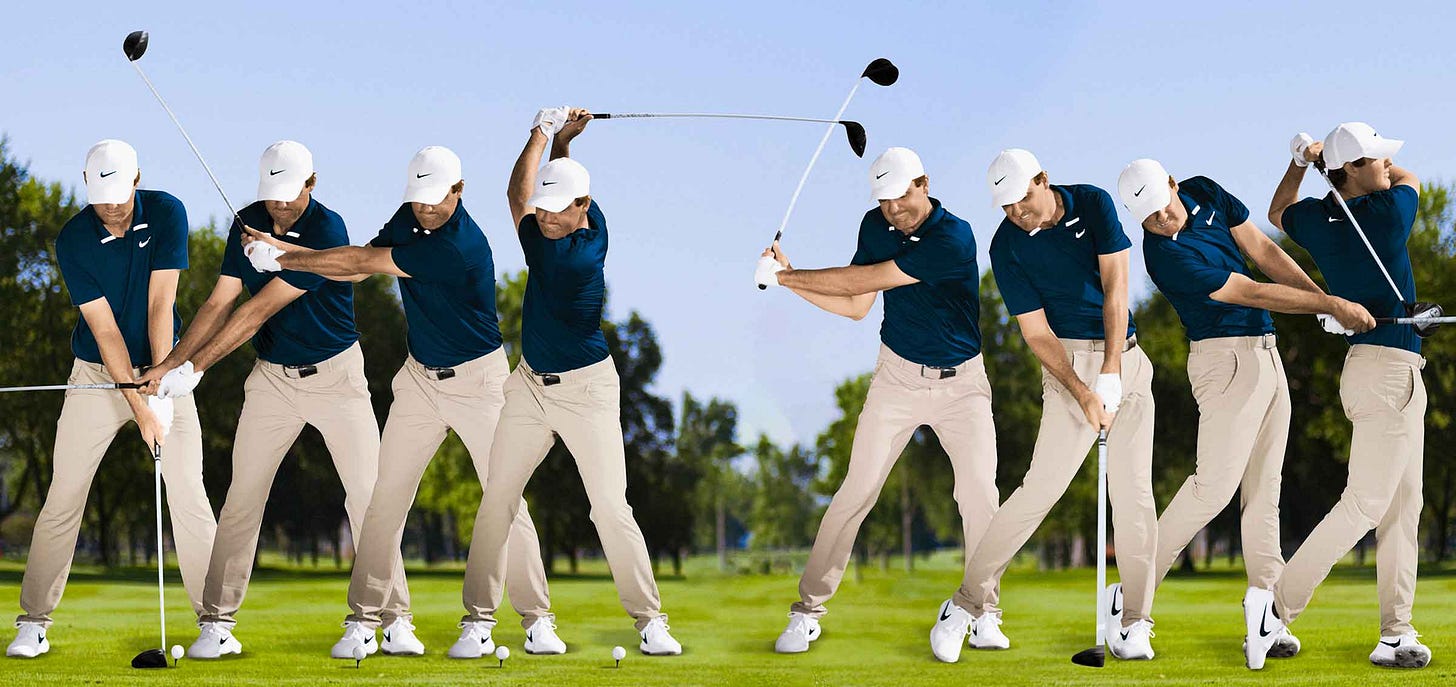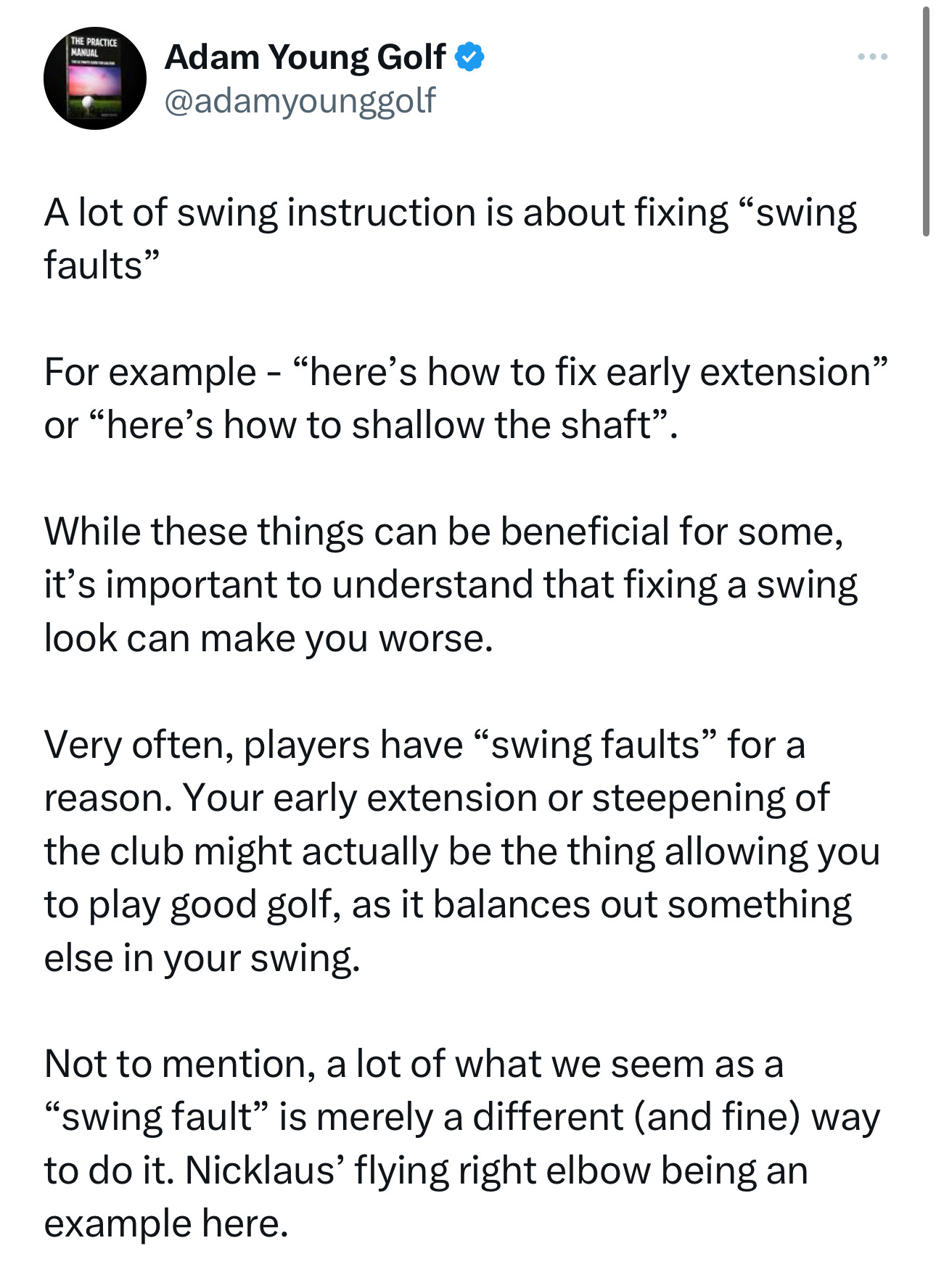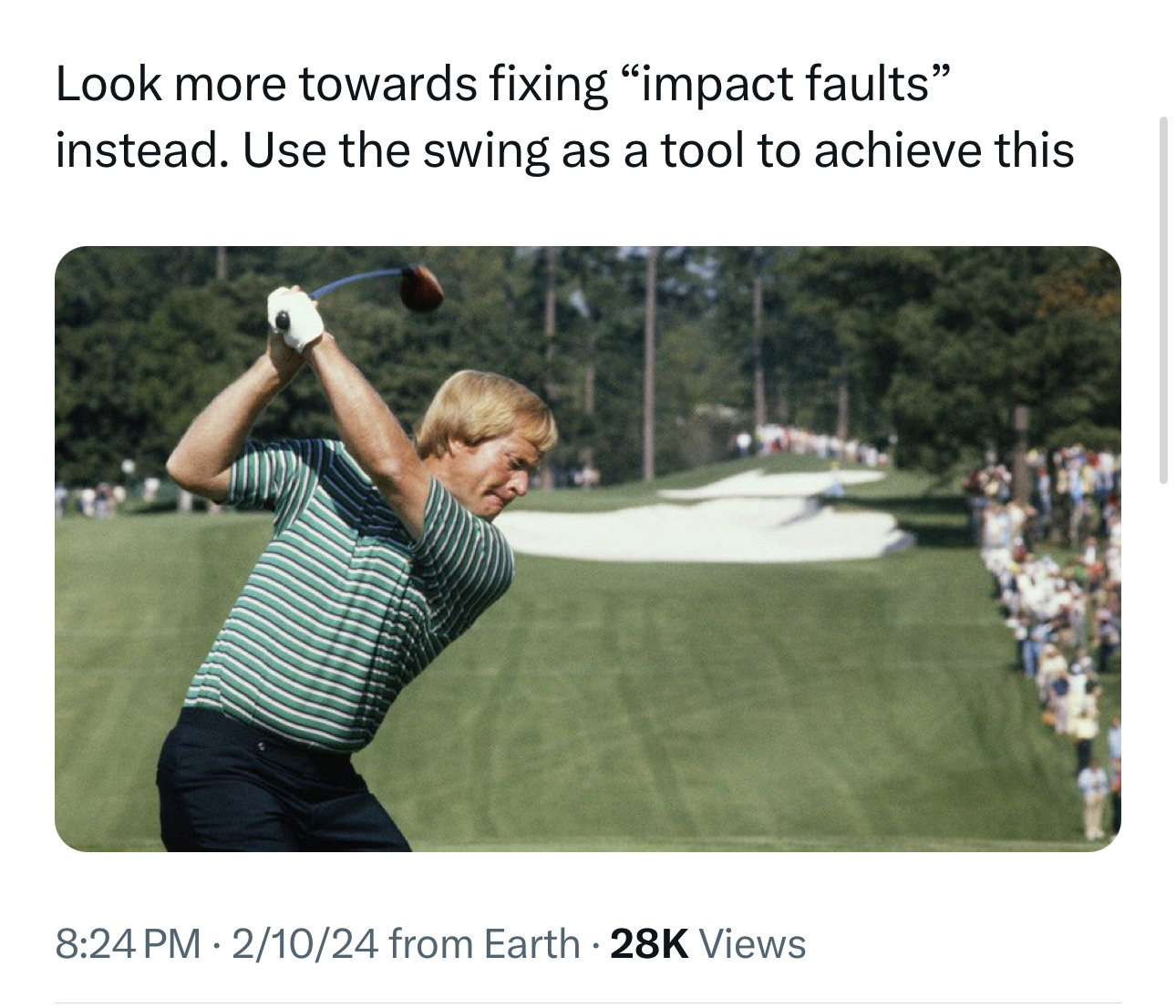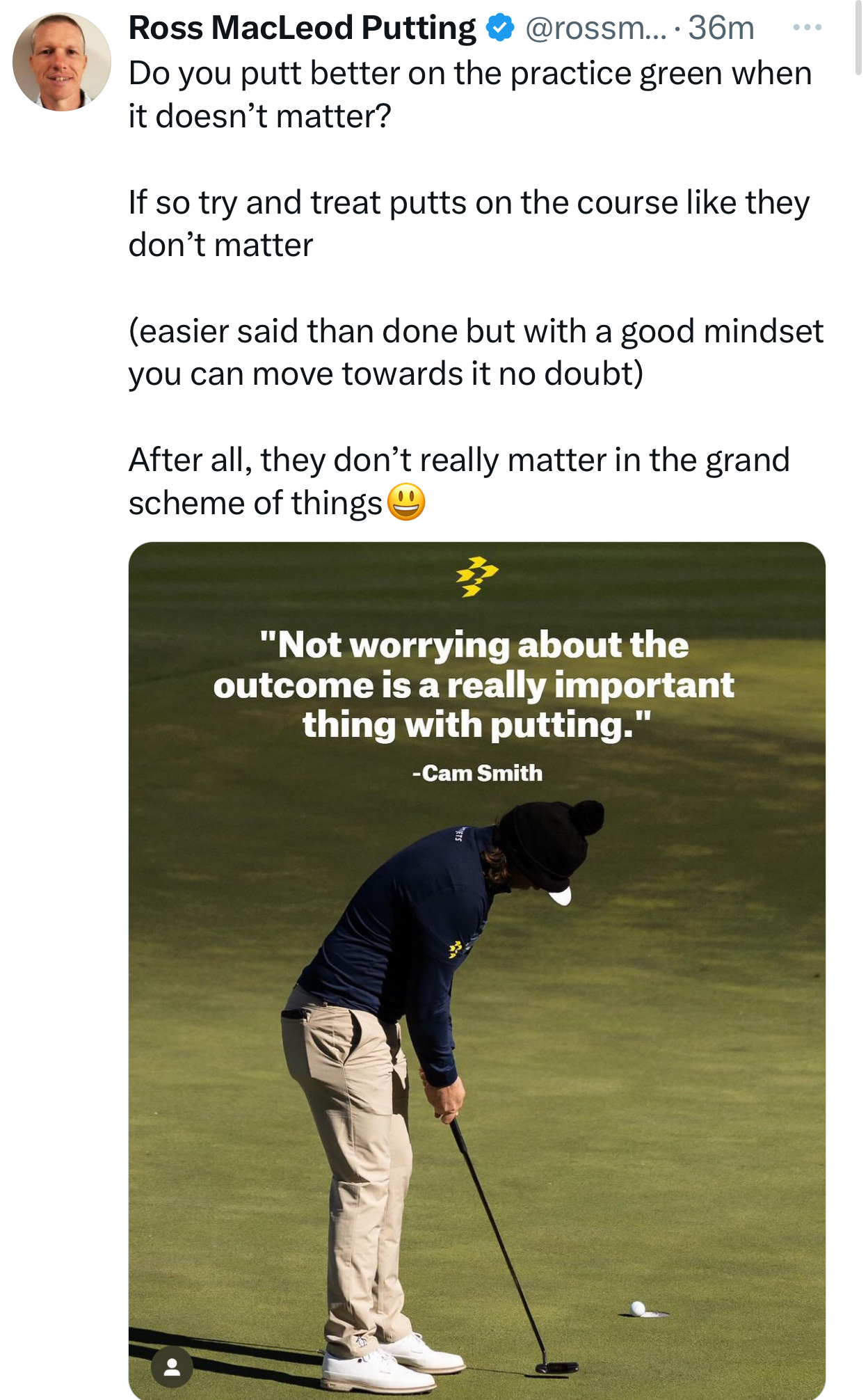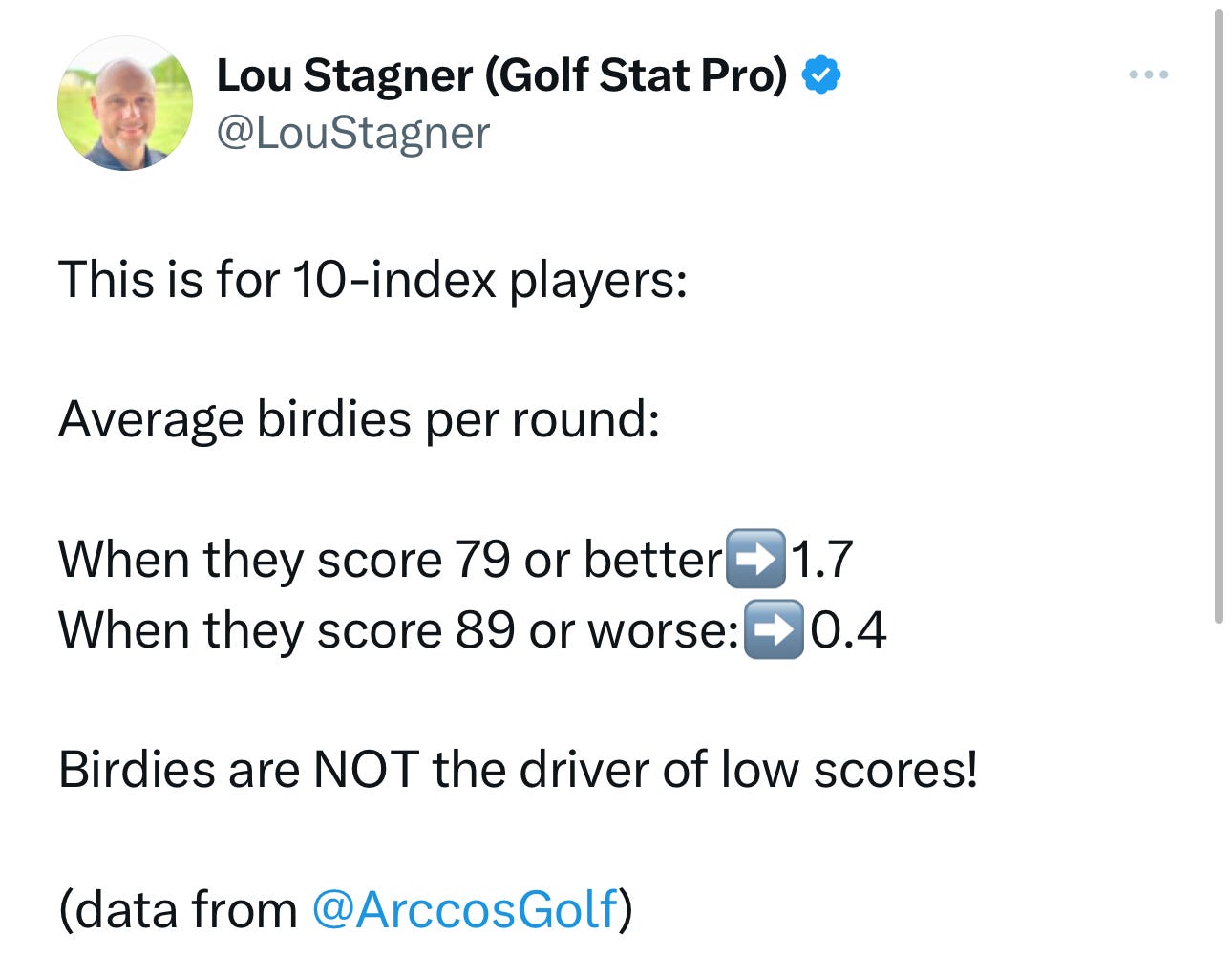The Best of February
Swing Your Swing, How to Focus, Better Practice, Fairways Revisited, Swing Faults, Not Worrying, Birdies vs Doubles
Today’s post is another monthly best-of summary to resurface some things you might have missed in February. Click on the link for the full post. Enjoy!
Swing Your Swing
Link: Edition #33
Below is a 7-minute analysis of Scottie Scheffler’s unique swing by Brandel Chamblee. Brandel expertly explains why Scottie’s swing works so well for him and compares it to past champions with unconventional swings.
It’s an excellent analysis that’s well worth the watch, but it got me thinking about amateurs and their swings. Do we focus on our swing too much? Or should we just “swing our swing” like Scottie?
I’m guilty of the former. I tinker and think about how my swing looks often. This week, I took some swings in my garage and watched the replays on my Rapsodo device. Ugh. I did not like what I saw.
The session then devolved into lousy shot after lousy shot while I focused on how my swing looked in the replay.
I would have been better off “swinging my swing” in this case. On the flip side, if we have fundamental flaws in our swing, we shouldn’t ignore them.
We need to find a balance between improving our swing and scoring. I know that’s not much of an answer, but it’s a balance that we need to be aware of if it goes to either extreme. (side note: this is where good coaching can really help!)
But I do think there is a lesson from Scottie for us swing-obsessive types…
It’s not how it looks; it’s how well you play.
<CLICK THE LINK FOR THE FULL POST>
Concentration: Learning to Focus
Link: Concentration: Learning to Focus
In the classic sports psychology book The Inner Game of Tennis, author Timothy Gallwey writes about mastering the mental game through improving focus. The book is dedicated to the mental side of tennis, but it applies to life and golf just as well.
In the chapter titled Concentration: Learning to Focus, Gallwey notes:
“My experience over the years is that the best way to quiet the mind is not by telling it to shut up, or by arguing with it, or criticizing it for criticizing you. Fighting the mind does not work. What works best is learning to focus it.”
SEEING THE BALL
Gallwey first suggests focusing on something subtle that’s not easy to see, for example, looking at the seams of the tennis ball instead of the ball.
“I have found that the most effective way to deepen concentration through sight is to focus on something subtle, not easily perceived. It’s easy to see the ball, but not so easy to notice the exact pattern made by the seams as it spins.”
Gawley describes this as SEEING the ball vs just WATCHING the ball.
For us golfers, maybe we look at the dimples on the golf ball, or a leaf on a tree in the distance as our target, or a blemish on the green as our putting aim. How often are we just WATCHING our target? Or maybe we don’t have a target at all.
The subtleness of the target tends to engross our minds completely because it is trying to watch the pattern, which helps us avoid overthinking. Our brains are preoccupied with the target, letting our bodies move naturally without interference.
<CLICK THE LINK FOR THE FULL POST>
The 80/20 Rule
Link: The 80/20 Rule
The 80/20 Rule (or Pareto principle) was named after economist Vilfredo Pareto, who observed that 80% of Italy was owned by 20% of the population. Another commonly used example of the Pareto principle is when a company makes 80% of its profits from 20% of its customers.
As you probably already guessed, the 80/20 Rule applies to golf, too.
“Roughly 80% of the effects come from 20% of the causes. Perhaps nowhere is this truer than as it pertains to scoring in golf.”
-Shane Jones of Breaking 80
The problem is that many golfers have the 80/20 rule inverted when practicing. We’re putting too much effort into areas that won’t give us an adequate return. We want to flip that 80/20 and focus on the 20% of the game that produces 80% of the results.
That means focusing on Driver, Wedges, and your short game (putting and chipping). This is the majority of our club usage and correlates best to on-course success. It will differ slightly for everyone, depending on your skill level overall and within the various facets of your game (which is why good data helps).
It’s not a science, but be mindful. We just don’t want to be going up and down our bag hitting 5 balls with each club. Sure, there are benefits to practicing with your 3-wood or 4-iron. We don’t want to ignore them, but we do want to be cognizant of how often we actually use certain clubs and whether we are getting the proper return for our effort.
To sum it up. Be aware of what you are focusing on at the range. Flip the 80/20 and practice smarter.
“Swing Faults”
Link: Edition #34
This tweet below from Adam Young is something I wish I understood years ago. Instead, I beat my head against a wall, “fixing” various aspects of my swing with frustrating results.
As Adam says, some “flaws” are not necessarily bad, but they might be there to compensate for a different flaw. So, fixing your wrist angle, takeaway, turn, or shoulder tilt might have a domino effect that leaves your game in shambles.
I have experienced this many times. You or I might even be right in identifying an issue, but it might require multiple adjustments. I’m not saying don’t experiment or try to improve various aspects of your swing, but beware of the negatives to going too far in the direction without a keen eye.
This is where coaching can put you on the correct path and save you years of frustration.
<CLICK THE LINK FOR THE FULL POST>
Fairways Revisited
Link: Fairways Revisited
Below is every past T2C post on hitting fairways and their importance (or lack thereof). TLDR: Stop stressing about missed fairways. Ingrain this in your DNA.
Finding Fairways
“Successful tee shots are about keeping the ball in play and avoiding trouble than hitting fairways. Fairway bunkers, trees, penalty areas, and out of bounds cost golfers far more strokes than hitting it in light rough.”
-Jon Sherman (@practicalgolf)
I know checking off a fairway hit on the scorecard feels nice, but it’s overrated. The #1 goal should be avoiding trouble off the tee and then hitting it as far as you can while achieving goal #1.
A little trick is to tee up on the same side of the tee box as the trouble. So if there’s water on the left, I’ll tee up on the left side of the tee box and slightly turn my body away from the water. This shifts my dispersion area away from the hazard and gives me a bigger margin for error.
Another key part is accepting that the dispersion of your drive is going to vary a lot, no matter how good you get.

The chart above is a dispersion chart for a top-ranked amateur. The player’s driver variance is roughly 70 yards from left to right!
Stop worrying about fairways, aim away from trouble, and, as Lou says, Manage Your Expectations.
<CLICK THE LINK FOR THE FULL POST>
🐦 Tweets of the Week 🐦
Link: Edition #36
Great tweet from Ross. To some, “not caring” might sound like weird advice, but it works. Focus on the process and worry less about the outcome. This can help free your mind up to focus and let your body move naturally.
Also, knowing the odds and having realistic expectations helps. As I’ve said many times here, a PGA Tour pro makes an 8-foot putt 50% of the time.
How can we be mad when we don’t make a 20-footer? Know the odds, do your best with your setup, stroke, and speed, and let the chips fall where they may.
On to the next shot.
<CLICK THE LINK FOR THE FULL POST>
🔢 Stat(s) of the Week 🔢
Link: Edition #35
What a stat from Lou. The difference between an 89 and a 79 is just over one birdie. One! This further proves that it’s all about avoiding big scores, not more birds
<CLICK THE LINK FOR THE FULL POST>
If you have any questions or comments about the newsletter, please comment below or email me at the2ndcut@substack.com.
Have a great weekend!





